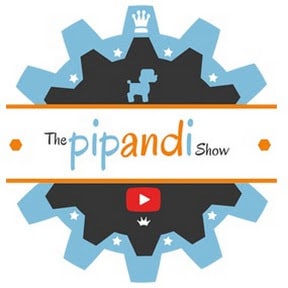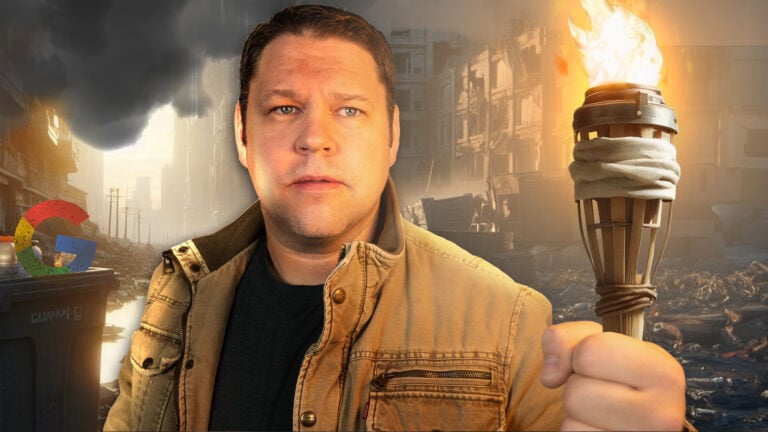If you’ve ever started a WordPress site then you know what I’m talking about.
You dive right in, find all the plugins that will make your site amazing! You pick a theme that you heard was popular and you start writing articles… tons of articles. And now you’re months in and you realize that there’s something not quite right with your site.
You’ve got lots of content and some traffic now so you don’t want to abandon your site, but there’s a part of you that wishes you could just start over with a clean slate so you could build it right!
If you haven’t had this experience that’s GREAT! That makes me happy for you. But it probably means you haven’t tried to build a website on your own yet. Or it means you learned it right from someone else before you ever got started. But for the other 99% of us we wish there was someone who would just tell us which pitfalls to avoid up front.
Here at Income School we’ve found some of the worst but most common mistakes that trip up new WordPress users. We didn’t learn them from a book or by taking a class.
In many cases, we learned these mistakes by making them and as we’ve consulted with other site owners who made them too.
So here they are. 17 of the most common mistakes you don’t have to make when you build your WordPress site.
Let’s go!
#1. Forgetting to setup permalinks
When you make a new page or write a new post, WordPress will automatically create a web address (URL) for that web page. And there’s a template that WordPress will use for that URL every time. The bad news is that the default setting uses a number scheme that won’t make sense to anyone except maybe you. You’ll end up with URLs that look like this.
yoursite.com/?p=102
The good news is that this is really easy to change. First of all, you can customize the URL for any post or page right when you create it. I often do this on big articles so that the URL is exactly what I want. You do that on the new page/new post page on your WordPress dashboard. Right near the top of the page you can see what the auto-generated URL is and you can click right there to edit it.
But since you probably don’t want to have to worry about it for every single post, you can just change the template for your permalinks. And it’s actually really easy. Here’s what you do.
- On your WordPress dashboard on th eleft side, hover your mouse over “Settings”
- Go down the list of options on settings and click on “Permalinks”
- Now, pick a different permalinks setting than the default. We like to use the one called “Post Name”
What’s important is that you do this right when you setup your site. Don’t wait. If you wait, then any articles or pages that you create will have your old link settings. And if these links change after they’re been live for a while, then any links anywhere on the internet that point to those pages will no longer lead to those pages. Instead, people will get a “Page Not Found” error. You don’t want that.
So if you’re building a site, set up your permalinks right at the start.
#2. Not backing up your site
Backing up your blog is absolutely essential. It is always possible that your hosting company will have a data failure or make a mistake that loses data on your site. A good host such as Bluehost keeps a backup, so if anything happens you can just call them and they’ll restore your site.
But even so, it’s always smart to have at least one backup stored somewhere else. You can look at the vast array of backup plugins and pick one that works for you. But no matter what, back up!
#3. Using a free theme
If you’re starting a site, you probably just signed up for hosting (or you will). Which means you just forked out money for a year of hosting. Since your site is just getting started and isn’t earning any money yet, you might be tempted to save some money by using a free theme. Don’t do it!
Not using a powerful theme is one of the biggest mistakes you can make when you start a WordPress site. You see, the theme is the backbone for the whole site. It’s the code that determines your site structure and appearance. Any site plugins that you get will have to work with your theme and if your theme was free, you can’t really expect to get a lot of support. Things will break, it’s just a matter of time.
Not to mention, a good theme will give you lots of fantastic options to customize your site and make it look just how you want it. The free themes tend to look really bloggy and are harder to customize if you want to do much beyond a basic blog. If you want a really good looking site, even if it’s supposed to look like a blog, then I highly recommend that you get a good theme.
We’ve used a lot of themes over the years and we’ve found one that we really love. It’s called X-Theme. Most really good themes are expensive. We’re talking around $100 and on up from there. But X-Theme is extremely powerful and super customizable and only costs about $64. If you want to learn more about X-Theme and why we love it so much, check out our review of it here.
Check out current pricing for X-Theme here.
#4. Customizing your theme
So I just talked about how customizable some themes can be and how awesome that is. So why am I now saying that customizing your theme is a mistake?
I’m not.
What I am saying, though, is that you should absolutely not try to customize your site outside of the settings that come available with your theme. The purpose of the theme is to provide you with the ability to make your side look how you want it. So if you have to add code in addition to the theme that you have, then you probably didn’t buy the right theme. That’s part of why I love X-Theme so much, because it can be customized to look pretty much however I want.
The reason I’m adamant about this pretty much boils down to two things. First, you can spend hours and hours trying to customize your site using code. It will eat up your life. But you should be spending those hours working on fantastically useful content for your site. Your site should look good pretty much out of the box with some basic settings. Second, when something updates with WordPress, or your Theme, or a plugin, your customizations can begin to break. All that work you put into it gets wasted. Even looking at your site on a mobile device can get all messed up. Your theme was designed to handle things a certain way, and your customizations can inadvertently break your site when it’s looked at on different screen resolutions.
So if there’s something you want to do to your site to make it look a certain way, and if you do a Google search to find out how to do it, and if that Google search leads you to articles that start talking about CSS or PHP code changes, then stop! No matter what theme you use, if you have questions you should go to the support page for that theme. Chances are they have instructions and tutorials there for you. Plus, a lot of them have active forums where you can ask specific questions and get help pretty quickly.
The only exception is shortcodes, which are little lines of code that are created to work within your theme. Those are okay because they are created for your theme! Any other code, leave it alone.
Just don’t go nuts with code. Use what comes with your theme.
#5. Only writing short posts
We have been testing this for many many years, and have found–almost without exception–the longest posts are the ones that rank the best on Google. In fact, on my most popular blog, 100% of the top 20 posts I’ve ever written are over 3,000 words each!
Most bloggers start their blogs by writing “quick and easy” content–thinking that will encourage people to read their posts. That makes sense, but it has simply never worked for me.
Write long, meaty posts that feel more like a chapter in a book than anything else.
If you want more direction on post lengths and topics, check out Niche Site School where we walk you through the different types of articles to write, how long they should be, and how to find great topics.
#6. Not resizing images
When you upload an image to your WordPress website, it won’t automatically resize the image for you. It will change the way the image is displayed so it’s the right size, but it doesn’t actually resize the actual file. This means that images will take FOREVER to load on your site.
It takes some extra time, but it’s very important to resize each image. I can recommend http://resizeimage.net/ as a quick way to do this online, and it’s free. I typically make a full width image 900px on the long edge. If it’s going to have text wrapping on the sides of the image, then go with 350px.
#7. Too many plugins fighting each other!
Let’s just state a fact: the more plugins your site has, the more likely you are to run into technical issues on your site. I have a hard and fast rule that I never allow more than 20 plugins on a site, but I’ve also spent years testing plugins to make sure I have well-made plugins.
If you’re starting out, I wouldn’t recommend more than 8 plugins your whole first year.
#8. Using a password that’s easy to guess
WordPress websites are constantly being spidered by machines who want to break in and use your website to send spam or viruses. In fact, I have one site with a lot of traffic that receives over 200 attempts per day to guess my admin username and password!
Be absolutely certain you have a unique username and password and that you do not use that password for any other site.
#9. Using a junky host
Choosing your host is a really important decision. Frankly, there are many very good hosts out there, but there are just as many bad ones, and searching Google for reviews is not at all reliable because so many people are willing to recommend any host as long as they get a good commission for their recommendation.
If you want an example of what I mean by junky host, check out this article on why I dumped Storm on Demand for hosting a while back.
I’ve been a Bluehost customer since 2007 and they are absolutely the company I recommend for your first host. No question. When your site blows up and gets over 300,000 page views per day, it’ll probably be time to graduate to something more expensive like WPEngine.
#10. Trying to SEO your way to traffic
PLEASE, for your own sake, read this post about how SEO simply doesn’t work before you decide to try “link building” to build your traffic. Stop messing around with SEO and just write great content.
#11. Using junky images
There is a pretty dramatic difference between professional photos and me with my point-and-shoot camera. There’s also a difference between nice stock photos/graphics and free clipart. When you write a blog post, you usually want a nice image with it. In some cases you’ll want to add some wording to the image, but in a lot of cases the image alone is great.
There are certainly times when using a photo that you obviously took on your cell phone makes a lot of sense. If you’re reviewing a product that you personally own or used, then snapping a photo of that product on your phone and using that picture gives the readers a sense that you really did use that product. It makes that image and the associated post seem more real.
But for featured images for posts, you really want to use something that looks nice. Stock photos can get really expensive (often around $10 per photo) and that’s not really practical for a new blog. That’s why we recommend Storyblocks. We found them recently and once we saw what they have to offer, we immediately signed up. For just $99 per year, you get unlimited downloads of thousands of photos and graphics in their database. At that price, and with the number of articles we write, it’s absolutely worth the cost. You can even sign up here.
#12. Missing out on Amazon commissions
Every blog can find good products to recommend to readers. I say that without any reservations. If you have a site about any topic, then you can find products that you can link to without making your site seem spammy. So if you haven’t linked to any products on Amazon yet, then do it.
One easy way to link to products is to have a page on your site with your recommended tools/gear/resources. Use this page to describe all of the tools that you use and recommend to others. You can also write posts that review products or compare one product to another. These are great opportunities to link to products that can earn you a commission.
Amazon Associates is Amazon’s affiliate program and it’s extremely easy to get started. Just go to this page to setup your account.
#13. Failing to block spam
Here on Income School, there was a time we were getting literally hundreds of spam comments per day. Fortunately, we have a plugin called WP-SpamShield that does a great job blocking the spam that tries to get on our site.
Failing to block spam comments, trackbacks, and contact forms is a great way to make your site look like garbage. There are a lot of people out there who use bots to go out and post spam comments on other sites with links back to their site. They do this to create links pointing to their site in order to trick search engines into bringing them traffic. Other spammers will use bots to fill out contact forms on your site and send you phishing emails. If there’s some nefarious thing that people could do by spamming your site, chances are somebody is doing it.
So don’t let your site be a victim of spamming. It’s just so easy to avoid.
#14. Failing to test Social Media buttons
Your site is up. You have content. And now you installed a plugin for social media buttons so everyone can share your posts. That’s great, but have you tested them to make sure they work?
We’ve seen this before. In fact, we’ve made this mistake before. Just because a social media plugin looks great does not mean it works great. In our case, when we switched to a new setup for social media buttons, our shares went up 4x. That’s right, 4x more shares overnight because we started using a system that works.
I’m going to make another pitch here for X-Theme. Rather than using another plugin that may or may not work well, if you just use X-Theme they have a nice shortcode that makes it easy to add social media sharing buttons to any page or post you want.
#15. Overdoing it on Social Media
How many social media sharing buttons do you really need?
A lot of people will put 6 or 7, sometimes even more, social media sharing buttons at the bottom of their articles. They hope that the more channels they get their message to, the more the word will spread.
We find this to not necessarily be the case. We find that by focusing our social media marketing to 2 or maybe 3 social media channels, we get the best return for our time investment. By focusing on just a couple, we focus our message and build a strong presence. If we have a strong presence on Pinterest and YouTube, because that’s where we focus our social media efforts, then it gets easier and easier all the time to get people from those channels to our site. But if we try to focus on 6 or 7 we find that our presence ends up really small on each of them and none is very effective.
Now, if we’re building a strong presence on Pinterest and YouTube, why would we really want people sharing one of our articles on Redit or Linkedin? That doesn’t really make sense. You might get a few more people to see it, but the message of that article won’t be backed up by a strong presence on that social media channel and you’re not likely to get much traffic. Plus, if people are sharing your content on social media sites where you don’t have a presence, it gets really hard to control the message that’s being shared.
So pick a couple social media sites that actually make sense for your topic and stick with them.
#16. Making your blog too “nice”
Most bloggers spend a lot of their time writing interesting articles and making their blog look good. Which is a good thing to do. But notice that I said, “most bloggers”. Everyone is doing this. No matter how “nice” you make your site look and how “good” your articles are, your site is probably just going to be another repository of articles.
So while you’re writing your good articles and making your blog look nice, think about what you can do to stand out. What insane thing could you do to make your blog truly unique. Maybe it’s a weekly or monthly article or YouTube video that’s just a bit out there. Whatever it is, it needs to be something that gets people excited, intrigued, or emotional.
Here’s one example. There’s a company called Liberty Safe. They state that their safes are the most fire/tornado/explosion proof safes out there. So what did they do to show it? They made a YouTube video where they literally blew up one of their safes and one of the competition’s. I’m not saying you have to blow up a product, but you should do something. What that is is up to you.
#17. Setting up your site on WordPress.com
If you want to make a blog that can actually make money, you need to set it up using WordPress.org. Wordpress.com is a site that uses the WordPress dashboard to manage your site, but they also host your site for free. The benefit of that is that your site hosting is free. But the downsides are numerous if you’re doing anything other than a personal blog.
If you go to WordPress.com expecting to setup a beautiful blog to earn a side or even full-time income, you’ll find yourself disappointed pretty quickly. First of all, if you setup your free site there, your domain name will be something like this.
yoursite.wordpress.com
You don’t actually get your own domain. That domain looks cheap and unprofessional, because it is. Second, WordPress.com sites don’t support good themes like X-Theme. You’re limited to the themes that WordPress.com lets you use. Along the same lines, WordPress.com sites don’t support external plugins. So all of the stuff we’ve talked about with Amazon affiliate marketing, spam blocking, and so many other features available on self-hosted WordPress sites… all of that goes up in smoke.
Your WordPress.com site will be horribly constrained to the features available for the free site. Yes it’s free, but it’s not worth it. If you actually want to earn an income you need to go with a site that’s hosted somewhere else. As mentioned above, we recommend Bluehost for anyone getting started. They’re fantastic and very easily integrate with WordPress. It only takes a couple minutes after buying your hosting to get WordPress installed and to get to work blogging.
That about covers it
Really, you could make about a million mistakes as you get your first site up and running. But don’t sweat it. Just avoid these most common and most destructive mistakes here and you’ll be just fine. You’ll learn new things along the way to continuously make your site better.
You’ll learn and grow and as you do, so will your income.
We’ve told you how to avoid some of the biggest and most common WordPress mistakes. But there’s a lot more to building a successful and profitable niche website than avoiding mistakes. If you want to learn how we build profitable niche sites from the ground up, check out Niche Site School.









